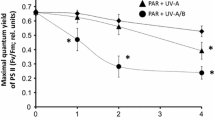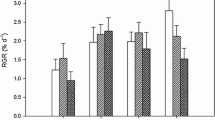Abstract
Growth as an integrative parameter of all physiological processes was measured in young sporophytes of temperate Laminaria digitata, Laminaria saccharina and Laminaria hyperborea exposed in the laboratory to irradiance consisting of either only photosynthetically active radiation (PAR) or to a spectrum including ultraviolet radiation (UVR) (PAR+UVA+UVB) by use of cut-off glass filters. Size increment was measured every 10 min over a period of 18–21 days using growth chambers with on-line video measuring technique. In the chamber, plants were grown at 10±2°C and 16:8 h light–dark cycles with 6 h additional UVR exposure in the middle of the light period. Tissue morphology and absorption spectra were measured in untreated young sporophytes while chlorophyll a content and DNA damage were measured in treated thalli at the end of the experiment. Sensitivity of growth under UVR was found to be related to the observed upper depth distribution limit of the upper sublittoral L. digitata, upper to mid sublittoral L. saccharina and lower sublittoral L. hyperborea. Tissue DNA damage is, however, dependent on thallus thickness which minimizes UVR effect where outer cell layers shade inner cells and provide longer pathlength for UVR. Exposure to UVR causes cellular, enzymatic and molecular damage. Presence of UV-absorbing compounds further reduces effective UVR from reaching physiological targets. The cost of producing higher amount of UV-absorbing compounds and effective DNA repair mechanism can, however, divert photosynthate at the expense of growth. Tissue chlorophyll a content was not significantly different between treatments suggesting a capacity for acclimation to moderate UVR fluence. Growth acclimation to repeated UVR exposure was observed within a period of 12 days while growth inhibition was observed after a longer UVR exposure period of 21 days. The results give further insight into the effects of UVR on the cellular level and show how ecological parameters such as the upper depth distribution limit are dependent on cellular processes.







Similar content being viewed by others
References
Aguilera J, Dummermuth A, Karsten U, Schriek R, Wiencke C (2002a) Enzymatic defenses against photooxidative stress induced by ultraviolet radiation in Arctic marine macroalgae. Polar Biol 25:432–441
Aguilera J, Bischof K, Karsten U, Hanelt D, Wiencke C (2002b) Seasonal variation in ecophysiological patterns in macroalgae from an Arctic fjord. II. Pigment accumulation and biochemical defence systems against high light stress. Mar Biol 140:1087–1095
Arnold TM (2003) To grow and defend: lack of tradeoffs for brown algal phlorotannins. Oikos 100:406–408
Bischof K, Kräbs G, Wiencke C, Hanelt D (2002) Solar ultraviolet radiation affects the activity of ribulose−1,5-biphosphate carboxylase-oxygenase and the composition of photosynthetic and xanthophyll cycle pigments in the intertidal green alga Ulva lactuca L. Planta 215:502–509
Brinkhuis BH (1985) Growth pattern and rates. In: Littler MM, Littler DS (eds) Handbook of phycological methods: ecological field methods: macroalgae. Cambridge University Press, Cambridge, UK, pp 461–477
Carr GM, Duthie HC, Taylor WD (1997) Models of aquatic plant productivity: a review of the factors that influence growth. Aquat Bot 59:195–215
Caldwell MM (1971) Solar ultraviolet radiation and the growth and development of higher plants. In: Giese AC (eds) Photophysiology. Academic Press, New York, pp 131–177
Caldwell MM, Robberecht R, Flint SD (1983) Internal filters: prospects for UV-acclimation in higher plants. Physiol Plant 58:445–450
Croce R, Cinque G, Holzwarth AR, Bassi R (2000) The Soret absorption properties of carotenoids and chlorophylls in antenna complexes of higher plants. Photosynth Res 64:221–231
Dring MJ, Makarov V, Schoschina E, Lorenz M, Lüning K (1996) Influence of ultraviolet-radiation on chlorophyll fluorescence and growth in different life-history stages of three species of Laminaria (Phaeophyta). Mar Biol 126:183–191
Franklin LA, Forster RM (1997) The changing iradiance environment: consequences for marine macrophyte physiology, productivity and ecology. Eur J Phycol 32:207–232
Han T, Kain JM (1996) Effect of photon irradiance and photoperiod on young sporophytes of four species of the Laminariales. Eur J Phycol 31:233–240
Hanelt D, Melchersmann B, Wiencke C, Nultsch W (1997a) Effects of high light stress on photosynthesis of polar macroalgae in relation to depth distribution. Mar Ecol Prog Ser 149:255–266
Hanelt D, Wiencke C, Nultsch W (1997b) Influence of UV radiation on photosynthesis of Arctic macroalgae in the field. J Photochem Photobiol B 38:40–47
Henry BE, van Alstyne KL (2004) Effects of UV radiation on growth and phlorotannins in Fucus gardneri (Phaeophyceae) juveniles and embryos. J Phycol 40:527–533
Jacobsen S, Lüning K, Goulard F (2003) Circadian changes in relative abundance of two photosynthetic transcripts in the marine macroalga Kappaphycus alvarezii (Rhodophyta). J Phycol 39:888–896
Johansson G, Snoeijs P (2002) Macroalgal photosynthetic responses to light in relation to thallus morphology and depth zonation. Mar Ecol Prog Ser 244:63–72
Littler MM, Littler DS (1980) The evolution of thallus form and survival strategies in benthic marine macroalgae: field and laboratory tests of a functional form model. Am Nat 116:25–44
Long SP, Humphries S, Falkowski PG (1994) Photoinhibition of photosynthesis in nature. Annu Rev Plant Physiol Plant Mol Biol 45:633–662
Lüder UH, Clayton MN (2004) Induction of phlorotannins in the brown macroalga Ecklonia radiata (Laminariales, Phaeophyta) in response to simulated herbivory—the first microscopic study. Planta 218:928–937
Lüning K (1979) Growth strategies of three Laminaria species (Phaeophyceae) inhabiting different depth zones in the sublittoral region of Helgoland (North Sea). Mar Ecol Prog Ser 1:195–207
Lüning K (1985) Meeresbotanik: Verbreitung, Ökophysiologie und Nutzung der marinen Makroalgen. Georg Thieme Verlag, Stuttgart, pp 375
Lüning K (1992) Day and night kinetics of growth rate in green, brown, and red seaweeds. J Phycol 28:794–803
Lüning K (1994) Circadian growth rhythm in juvenile sporophytes of Laminariales (Phaeophyta). J Phycol 30:193–199
Lüning K (2001) Circadian growth in Porphyra umbilicalis (Rhodophyta): spectral sensitivity of the circadian system. J Phycol 37:52–58
Pascal A, Gradinaru C, Wacker U, Peterman E, Calkoen F, Irrgang K-D, Horton P, Renger G, van Grondelle R, Robert B, van Amerongen H (1999) Spectroscopic characterization of the spinach Lhcb4 protein (CP29), a minor light-harvesting complex of photosystem II. Eur J Biochem 262:817–823
Pavia H, Toth G, Åberg P (1999) Trade-offs between phlorotannin production and annual growth in natural populations of the brown seaweed Ascophyllum nodusum. J Ecol 87:761–771
Poppe F, Hanelt D, Wiencke C (2002) Changes in ultrastructure, photosynthetic activity and pigments in the Antarctic red alga Palmaria decipiens during acclimation to UV radiation. Bot Mar 45:253–261
Reed DC, Amsler CD, Ebeling AW (1992) Dispersal in kelps: factors affecting spore swimming and competency. Ecology 73:1577–1585
Robberecht R, Caldwell MM (1978) Leaf epidermal transmittance of ultraviolet radiation and its implications for plant sensitivity to ultraviolet-radiation induced injury. Oecologia (Berl) 32:277–287
Roleda MY, van de Poll WH, Hanelt D, Wiencke C (2004a) PAR and UVBR effects on photosynthesis, viability, growth and DNA in different life stages of two coexisting Gigartinales: implications for recruitment and zonation pattern. Mar Ecol Prog Ser 281:37–50
Roleda MY, Hanelt D, Kräbs G, Wiencke C (2004b) Morphology, growth, photosynthesis and pigments in Laminaria ochroleuca (Laminariales, Phaeophyta) under ultraviolet radiation. Phycologia 43:603–613
Roleda MY, Wiencke C, Hanelt D, van de Poll WH, Gruber A (2005a) Sensitivity of Laminariales zoospores from Helgoland (North Sea) to ultraviolet and photosynthetically active radiation: implications for depth distribution and seasonal reproduction. Plant Cell Environ 28:466–479
Roleda MY, Hanelt D, Wiencke C (2005b) Growth kinetics related to physiological parameters in young Saccorhiza dermatodea and Alaria esculenta sporophytes exposed to UV radiation. Polar Biol 28:539–549
Roleda MY, Wiencke C, Hanelt D (2006) Thallus morphology and optical characteristics affect growth and DNA damage by UV radiation in juvenile Arctic Laminaria sporophytes. Planta DOI 10.1007/s00425-005-0092-0
Schoenwaelder MEA (2002) The occurrence and cellular significance of physodes in brown algae. Phycologia 41:125–139
Schoenwaelder MEA, Clayton MN (1999) The presence of phenolic compounds in isolated cell walls of brown algae. Phycologia 38:161–166
Setlow RB (1974) The wavelengths in sunlight effective in producing skin cancer: a theoretical analysis. Proc Nat Acad Sci USA 71:3363–3366
Starr RC, Zeikus JA (1993) UTEX—the culture collection of algae at the University of Texas at Austin. J Phycol 29(Suppl):1–106
Steinberg PD (1995) Seasonal variation in the relationship between growth rate and phlorotannin production in the kelp Ecklonia radiata. Oecologia 102:169–173
Suzuki L, Johnson CH (2001) Algae know the time of day: circadian and photoperiodic programs. J Phycol 37:933–942
van de Poll WH, Eggert A, Buma AGJ, Breeman AM (2001) Effects of UV-B induced DNA damage and photoinhibition on growth of temperate marine red macrophytes: habitat-related differences in UV-B tolerance. J Phycol 37:30–37
van de Poll WH, Hanelt D, Hoyer K, Buma AGJ, Breeman AM (2002) Ultraviolet-B induced cyclobutane-pyrimidine dimer formation and repair in Arctic marine macrophytes. Photochem Photobiol 76:493–501
Vink AA, Bergen-Henegouwen JB, Nikaido O, Baan RP, Roza L (1994) Removal of UV-induced DNA lesions in mouse epidermis soon after irradiation. Photochem Photobiol 24:25–31
Wiencke C, Gómez I, Pakker H, Flores-Moya A, Altamirano M, Hanelt D Bischof K, Figueroa FL (2000) Impact of UV radiation on viability, photosynthetic characteristics and DNA of brown algal zoospores: implications for depth zonation. Mar Ecol Prog Ser 197:217–229
Wiencke C, Clayton MN, Schoenwaelder M (2004) Sensitivity and acclimation to UV radiation of zoospores from five species of Laminariales from the Arctic. Mar Biol 145:31–39
Acknowledgements
MY Roleda is supported by a scholarship from the German Academic Exchange Service (DAAD). We thank the divers of Biologische Anstalt Helgoland for collecting field materials and C. Daniel for pigment analysis. This is publication awi-n 15416 of the Alfred Wegener Institute for Polar and Marine Research. The experiments performed comply with the current laws of Germany.
Author information
Authors and Affiliations
Corresponding author
Additional information
Communicated by O. Kinne, Oldendorf/Luhe
Rights and permissions
About this article
Cite this article
Roleda, M.Y., Hanelt, D. & Wiencke, C. Growth and DNA damage in young Laminaria sporophytes exposed to ultraviolet radiation: implication for depth zonation of kelps on Helgoland (North Sea). Marine Biology 148, 1201–1211 (2006). https://doi.org/10.1007/s00227-005-0169-0
Received:
Accepted:
Published:
Issue Date:
DOI: https://doi.org/10.1007/s00227-005-0169-0




